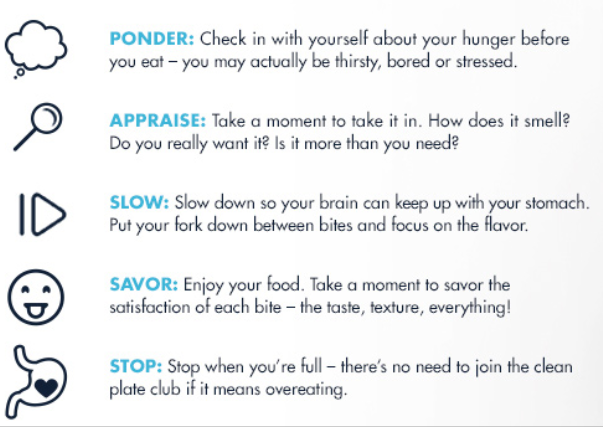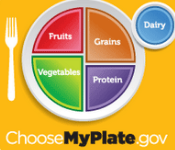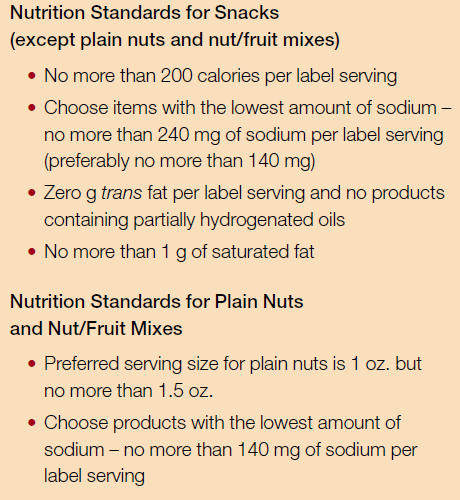
The following is a quick guide to reading the Nutrition Facts label. 

Start with the Serving Size
- Look here for both the serving size (the amount people typically eat at one time) and the number of servings in the package.
- Compare your portion size (the amount you actually eat) to the serving size listed on the panel. If the serving size is one cup and you eat two cups, you are getting twice the calories, fat and other nutrients listed on the label.
Check Out the Total Calories
- Find out how many calories are in a single serving. It’s smart to cut back on calories if you are watching your weight.
Let the Percent Daily Values Be Your Guide
Use percent Daily Values (DV) to help evaluate how a particular food fits into your daily meal plan.
- Daily Values are average levels of nutrients for a person eating 2,000 calories a day. A food item with a 5 percent DV of fat provides 5 percent of the total fat that a person consuming 2,000 calories a day should eat.
- Percent DV are for the entire day, not just one meal or snack
- You may need more or less than 2,000 calories per day. For some nutrients you may need more or less than 100 percent DV.
The High and Low of Daily Values
- Low is 5 percent or less. Aim low in saturated fat, trans fat, cholesterol and sodium.
- High is 20 percent or more. Aim high in vitamins, minerals and fiber.
Limit Saturated Fat, Added Sugars and Sodium
Eating less saturated fat, added sugars and sodium may help reduce your risk for chronic disease.
- Saturated fat and trans fat are linked to an increased risk of heart disease.
- Eating too much added sugar makes it difficult to meet nutrient needs within your calorie requirement.
- High levels of sodium can add up to high blood pressure.
- Remember to aim for low percentage DV of these nutrients.
Get Enough Vitamins, Minerals and Fiber
- Eat more fiber, potassium, vitamin D, calcium and iron to maintain good health and help reduce your risk of certain health problems such as osteoporosis and anemia.
- Choose more fruits and vegetables to get more of these nutrients.
- Remember to aim high for percentage DV of these nutrients.
Additional Nutrients
You know about calories, but it is also important to know about the additional nutrients on the Nutrition Facts label.
- Protein
A percentage Daily Value for protein is not required on the label. Eat moderate portions of lean meat, poultry, fish, eggs, low-fat milk, yogurt and cheese, plus beans and peas, peanut butter, seeds and soy products. - Carbohydrates
There are three types of carbohydrates: sugars, starches and fiber. Eat whole-grain breads, cereals, rice and pasta plus fruits and vegetables. - Sugars
Simple carbohydrates, or sugars, occur naturally in foods such as fruit juice (fructose) and milk (lactose) or come from refined sources such as table sugar (sucrose) or corn syrup. Added sugars will be included on the Nutrition Facts label in 2018. The 2015-2020 Dietary Guidelines for Americans recommends consuming no more than 10 percent of daily calories from added sugars.
Check the Ingredient List
Foods with more than one ingredient must have an ingredient list on the label. Ingredients are listed in descending order by weight. Those in the largest amounts are listed first. This information is particularly helpful to individuals with food sensitivities, those who wish to avoid pork or shellfish, limit added sugars or people who prefer vegetarian eating.









 Photo credit: Heather Victoria Photography
Photo credit: Heather Victoria Photography Forget the old Food Pyramid. The U.S. Department of Agriculture has a new online tool called MyPlate. It can help you and your family make smarter choices in a fun, engaging way. Check out how
Forget the old Food Pyramid. The U.S. Department of Agriculture has a new online tool called MyPlate. It can help you and your family make smarter choices in a fun, engaging way. Check out how 